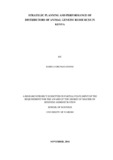| dc.description.abstract | The distributors of animal genetic resources in Kenya contribute to growth and
productivity of livestock industry, through enhancement of access to quality animal
genetic resources to the livestock farming communities. Adoption of improved
breeding technologies is important for the country meeting its long term goal of food
security, hence its ability to feed the rapidly growing human population. The Kenya
Animal Genetic Resources Centre (KAGRC) is an organisation with national mandate
to provide high quality animal genetic resources, and improvement of artificial
insemination. The organisation has appointed 47 distributors for its products, whose
mandate is to bring the products closer to the end users. Strategic planning has been
proposed as a major driver for success in organisations around the world. And,
different criteria for measuring performance are used to ascertain the continued
success of firms. The objective of this research was to determine the relationship
between strategic planning and performance in distribution of animal genetic
resources in Kenya. Secondary data were extracted from records of distributors of
animal genetic resources kept at KAGRC using a structured framework. Additionally,
a follow up with self-administered semi-structured questionnaire was sent to directors
of those firms which did not have complete records to collect primary data. Data
which were collected included sale volume, elements of strategic planning and
marketing mix. Elements of strategic planning included presence of vision and
mission statements, updated business plans, planning horizons and other demographic
factors. Data on marketing mix included those on product and price decisions,
promotional mix and distribution networks. Data analysis involved calculation of
market share for distributors of animal genetic resources, and this were presented
using Lorenz curves. Qualitative data were analysed using content analysis. The
relationship between firm’s sale volume and elements of strategic planning and
marketing mix was analysed using multiple regression. Approximately 40% of
distributors controlled 70% of total sale volume of animal genetic resources. 14% of
the firms had current business plans, while 25% had written vision and mission
statements. Organising farmer’s field days was the most common promotional mix,
but some firms had adopted social and electronic media to market their products. Only
geographical location of these firms was statistically associated with the firm’s sale
volume. These findings are useful for practising managers, policy makers and
researchers for understanding relationship between performance and strategic
planning in the context of developing countries. | en_US |



